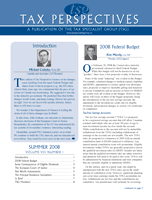
PDF Format
 Issue Contents Issue Contents
 All Issues All Issues
Summer 2008
Volume 8, Number 1
The information in Tax Perspectives is prepared for general interest only. Every effort has been made to ensure that the contents are accurate. However, professional advice should always be obtained before acting and TSG member firms cannot assume any liability for persons who act on the basis of information contained herein without professional advice.
The Principal Residence Exemption — Three Difficulties That Could Be Costly
By Michael Cadesky, FCA, TEP
Cadesky and Associates LLP (Toronto)
Very few things in life are free. In the world of Canadian taxation, the list is even shorter. One opportunity though, not to be missed, is the principal residence exemption.
Subject to certain limitations, the gain from the sale of the principal residence is completely tax-free. The limitations placed on the exemption relate to meeting the criteria necessary to qualify, rather than the absolute amount of the gain itself.
The first and most important limitation is the fact that a family (husband, wife and children under 18, in general), may only designate one principal residence in respect of any one year. If the family has two homes, such as a house in the city and a seasonal cottage, then only one may qualify for the principal residence exemption in any given year. It is not necessary to choose which residence will qualify for the exemption, until there is a sale. But, once a sale of one of the residences occurs, and that residence is designated as the principal residence, it is not possible to amend this selection in future years, even if the choice proved inopportune.
The principal residence exemption itself is computed as a fraction of the total capital gain. The fraction is the number of years that the residence is designated as a principal residence, over the total years of ownership. One extra year of eligibility is given. In the simplest case, if a residence is designated as the principal residence for all the years of ownership, the fraction will equal one, and the entire gain will be exempt. However, if it is only designated for some of the years in question, then a portion of the gain will be taxable. If held sixteen years, and designated as a principal residence for seven of those years, 50% of the gain would be exempt (one additional year of exemption is granted).
Herein lies the first difficulty with the exemption. The benefit of designating a property as a principal residence in any given year depends on two things; the number of years that the property will ultimately be owned until it is sold, and the gain which will be realized when it is sold. To illustrate how this can be problematic, consider the following simple example. In 2000, a family purchased a home in the city (the main residence) and also a summer cottage. The main residence was sold in 2007, for a gain of $400,000. The gain was claimed as being exempt under the principal residence exemption which, as a practical matter, simply means that the gain was left off the tax return entirely.
At that time, the summer cottage also had a gain of $400,000. However, after that, the value of the summer cottage shot up dramatically, and it was sold two years later for a gain of $800,000. By selecting the main residence as the principal residence up to 2007, the summer cottage may only be designated as a principal residence for 2008 and 2009 (2 years of a total period of ownership of 10 years). Under the formula, since one year is automatically given, this yields an exemption of 30%. Thus $240,000 of the $800,000 gain would be exempt, leaving $560,000 to be taxable.
The above example illustrates the main point, designating the wrong property for the exemption.
The second difficulty with the principal residence exemption is that the amount of land which may be claimed as being exempt is limited to one-half hectare (about one acre), unless the excess land can be shown to be necessary for the use and enjoyment of the property.
This creates problems, especially with cottage properties, where a large lot of lakefront property may easily exceed the size limits. Given the value of such properties today, this may become a material issue. While there is some case law on when excess land is considered "necessary" for the use and enjoyment of a property, the issue is far from clear.
The third difficulty with the principal residence exemption concerns foreign properties. Many people do not realize that a foreign residence can qualify as a principal residence. An old family home in the U.K., for example, may have become very valuable. The residence may qualify as a principal residence if it is occupied by a family member or close relative and, in some cases, even if it has been rented. So don't overlook a foreign property in the principal residence evaluation.
|